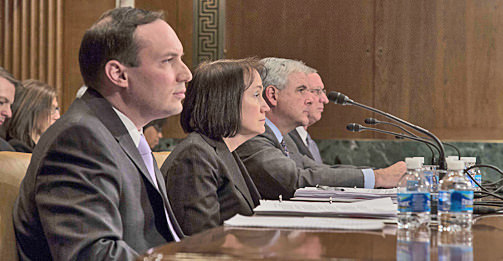UCS devotes a lot of ink to criticizing the Nuclear Regulatory Commission (NRC) for making bad decisions that reduce nuclear safety. So it is a refreshing change of pace to be able to praise the agency. On May 4, the NRC commissioners did the right thing and voted to overturn a ruling by the Atomic Safety and Licensing Board in the Indian Point license renewal proceeding that, had it stood, would have set a terrible precedent for scientific integrity in regulatory decision-making.

NRC Commissioners (Source: NRC)
This action may well lead to improvements in the methodology that the agency uses to analyze the health and economic impacts of potential nuclear accidents. If so, the NRC will have more accurate and realistic information about the consequences of nuclear accidents, which will help it make better-informed safety decisions.
Here’s the story in a nutshell: Entergy, the owner of the two operating Indian Point reactors in New York, has applied for a 20-year license renewal. The New York State Attorney General challenged a part of Entergy’s application called a “severe accident mitigation alternatives” (or SAMA) analysis. The Atomic Safety and Licensing Board, a panel of NRC administrative judges, dismissed New York State’s challenge. New York State then asked the NRC commissioners, who act as an internal appeals court, to review the decision. Finally, the commissioners overruled the Licensing Board, requiring Entergy to revise its analysis.
Cost-Benefit Analysis for Safety Upgrades
A SAMA analysis is essentially a cost-benefit analysis for making safety upgrades. It entails looking at possible modifications to a reactor that could reduce the risk of a severe (Fukushima-like) accident. For each potential modification, the monetary cost is compared to the monetary benefit for reducing the public health and economic impacts of a severe accident.
The NRC requires most reactors seeking a 20-year license renewal to conduct a SAMA analysis, and new reactor applicants to conduct a similar analysis. But the NRC does not require that applicants carry out any of the modifications, even those found to be cost-beneficial. The NRC maintains that none of the modifications are needed for “adequate protection” of public health and safety.
The monetary benefit will simply be the monetary value of the impacts of the severe accident that would be avoided by making the modification. In practice, these impacts are calculated using a computer program developed by the NRC in the early 1990s. The program (called MACCS2), models the release of radioactive materials from a nuclear accident and estimates the pattern of radioactive fallout. It also calculates the near-term radiation exposure to populations exposed to the plumes of contamination as they are evacuating or sheltering in place, as well as the long-term exposure from radioactive material deposited on the ground. The number of resulting cancer deaths is then converted into a monetary cost by putting a price on the value of human life, a problematic calculation that UCS has discussed elsewhere. The program also calculates the direct economic impacts of the contamination, including the cost associated with condemning residential and agricultural land and the cost of cleanup.
Garbage In, Garbage Out
Needless to say, these calculations are very complex and depend on many assumptions. The user must input hundreds of parameters, many of which are site-specific and have large uncertainties. The results can be very sensitive to the choices of these parameters.
Thus, to avoid a classic “garbage in, garbage out” problem and get technically meaningful results for a particular site, users must choose the input parameters carefully and document them thoroughly. In addition, users must conduct sensitivity analyses to study how the results vary with changes in the input parameters.
However, the NRC has generally refused to require that SAMA analyses meet stringent quality standards or that the results be robust with regard to uncertainties in the input parameters. Indeed, in a number of previous rulings in license renewal hearings, the NRC rejected contentions that the SAMA analyses submitted by applicants are inadequate, even if intervenors provided other analyses that used better data or more realistic assumptions. As long as the NRC determined that a SAMA analysis was “reasonable”—a weak standard— it could not be challenged. The NRC also ruled that SAMA analyses do not need to be peer-reviewed. Applicants started to believe that they could get away with pretty much anything in their SAMA analyses.
Too Much Garbage is Finally Too Much for the NRC
But finally, the NRC encountered a case where the applicant’s SAMA analysis was clearly unreasonable. The New York State Attorney General took issue with the values used by Entergy for the cost and time necessary to decontaminate areas that had been polluted with radioactivity, arguing in part that they didn’t take into account the current real-world experience encountered after the Fukushima Daiichi disaster. These values, which were default values in the program input files dating back to the early 1990s, have been used (after adjusting for inflation) by all other license renewal applicants—but the New York Attorney General was the first intervenor to question their pedigree. As it happens, the Attorney General’s team traced back the decontamination cost estimates to an unpublished 1984 report. Neither the NRC staff nor Entergy was able to locate the report, and neither party could provide any independent documentation or analysis supporting the values.
Nevertheless, the Licensing Board bizarrely ruled that even if the original document could not be located, it didn’t matter, since (and I’m paraphrasing here) the values had been vetted back in the day by smart people. But the NRC commissioners disagreed—they found the Licensing Board had erred in accepting those values on blind faith without having access to the initial analysis in which they were derived or other evidence on the record that the values were technically valid. In overturning the Licensing Board’s decision, the Commissioners ordered Entergy to do additional sensitivity analyses with regard to the decontamination cost and time parameters.
This decision is an affirmation that there is an upper bound to the amount of the garbage that the NRC will tolerate in SAMA analyses. As such, it strikes a small but significant blow for sound science at the NRC.
Hopefully, it will influence applicants and the NRC staff to use more realistic values for input parameters in their computer calculations, yielding more accurate estimates of the costs of nuclear accidents and the benefits of reactor modifications that can help to prevent them.
